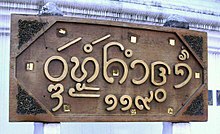
Back تايلانديه شماليه ARZ Idioma tai septentrional AST Báe̤k-buô Tái-guók-ngṳ̄ CDO Lanna (Sprache) German Idioma tai septentrional Spanish زبان تایلندی شمالی Persian Thaï du Nord French Bahasa Thai Utara ID Lingua thailandese settentrionale Italian 北タイ語 Japanese
| Northern Thai | |
|---|---|
| ᨣᩴᩤᨾᩮᩬᩥᨦ กำเมือง | |
 Tai Tham script traditional transcription (top) Thai alphabet currently popular with non-standard form (bottom) | |
| Pronunciation | [kam˧.mɯaŋ˧] ⓘ |
| Native to | Thailand (Chiang Mai, Lamphun, Lampang, Uttaradit, Phrae, Nan, Phayao, Chiang Rai, Mae Hong Son and Communities throughout Thailand) Myanmar (Tachileik, Myawaddy) Laos (Houayxay, Ton Pheung) |
| Region | Northern Thailand |
| Ethnicity | Northern Thai |
Native speakers | 6 million (2015)[1] |
Kra–Dai
| |
| Tai Tham script Thai script | |
| Official status | |
Recognised minority language in | |
| Language codes | |
| ISO 639-3 | nod |
| Glottolog | nort2740 |
Kam Mueang (Northern Thai: ᨣᩴᩤᨾᩮᩬᩥᨦ, กำเมือง) or Northern Thai language (Thai: ภาษาไทยถิ่นเหนือ) is the language of the Northern Thai people of Lanna, Thailand. It is a Southwestern Tai language. Kam Mueang has approximately six million speakers, most of whom live in the native Northern Thailand, with a smaller community of Lanna speakers in northwestern Laos.
Speakers of this language generally consider the name "Tai Yuan" to be pejorative[citation needed]. They refer to themselves as Khon Mueang (ᨤᩫ᩠ᨶᨾᩮᩬᩥᨦ, คนเมือง, [kʰon˧.mɯaŋ˧] – literally "people of Mueang" meaning "city dwellers"), Lanna, or Northern Thai. The language is also sometimes referred to as Phayap (พายัพ, Thai pronunciation: [pʰāː.jáp]), "Northwestern (speech)".
The term Yuan is still sometimes used for Northern Thai's distinctive Tai Tham alphabet, which is closely related to the old Tai Lue alphabet and the Lao religious alphabets. The use of the Tua Mueang, as the traditional alphabet is known, is now largely limited to Buddhist temples, where many old sermon manuscripts are still in active use. There is no active production of literature in the traditional alphabet, and when used in writing standard Thai script is invariably used. The modern spoken form is called Kam Mueang. There is a resurgence of interest in writing it in the traditional way, but the modern pronunciation differs from that prescribed in spelling rules.[2]

- ^ Northern Thai at Ethnologue (18th ed., 2015) (subscription required)
- ^ Natnapang 2004, Section 3.5.6 The changing pronunciation of the Lanna script and Kammuang As with all languages, the pronunciation of the written and spoken forms changes over time. This is another problem that Kammuang speakers may have when they learn to write the Lanna script. These changes occur in only some words, and there are no readily apparent rules to explain the changes....